Musings
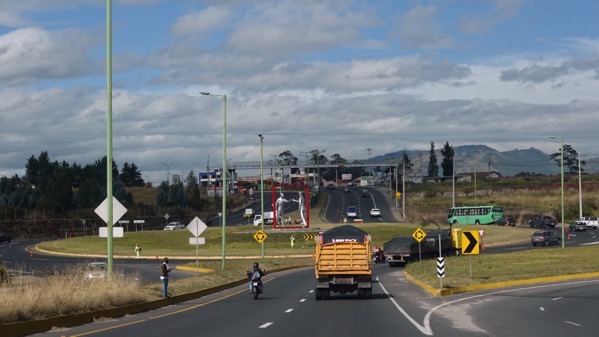
Traffic circle art. Today we drove south to Riobambo, observing flat valley bottomland, quebradas (dissected rivers), fewer flat areas, framing mountains, and modern life. A sample of images follows.

Río Chiche quebrada. Deep.

Out in the countryside, you can see the fields often go up-and-down on the slopes, rather than horizontal. Land division patterns usually have a particular history.

Huge numbers of shade agriculture structures here and there. This is one of the largest complexes we have seen. Some are just three or four adjacent. Also: dairy.

We’re on the right road (yay!), headed for Ríobamba, by Latacunga and Ambato.

Passing a military base. Another statue.
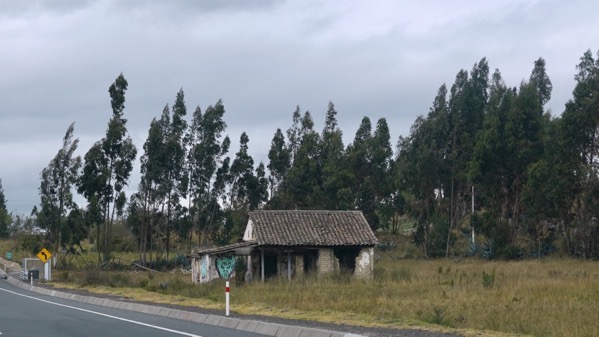
Abandoned structure. Why? Because the highway took their land and thus the family’s economic support? Speculating….
Also, we are beneath overcast, and the wind bends the trees.

Shade structures and open fields. The overcast was filling in.

Elegant fellow.
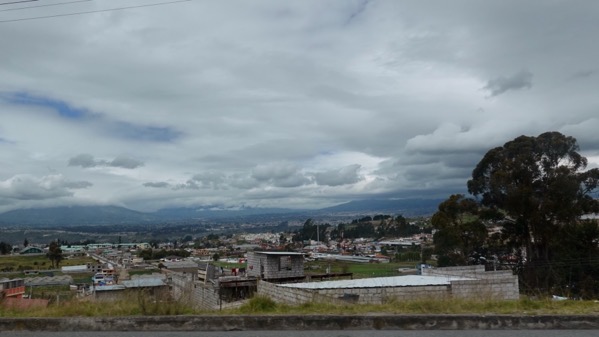
Farm fields transitioning to settlement.

Ambitious modern building.

Look at the distant mountains!

Landslide cleanup.

Steeper flank. We are closer to the cloud-bottoms.
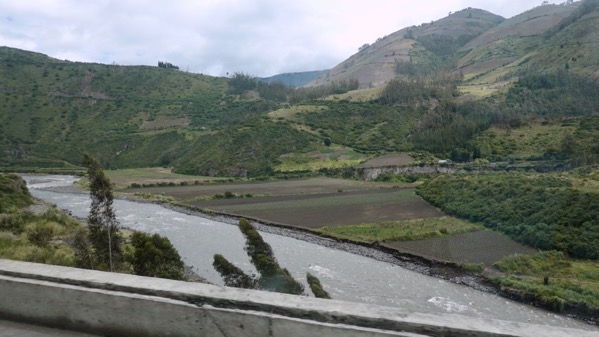
Riverside fields, plus those on steeper ground.
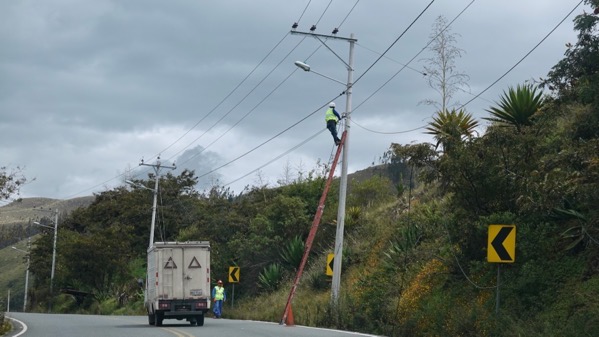
Stringing fiber. Two guys on two long red ladders (one pictured), and one on the ground, and another further along with the spool. Never spotted a truck.

In-town lumber mill.
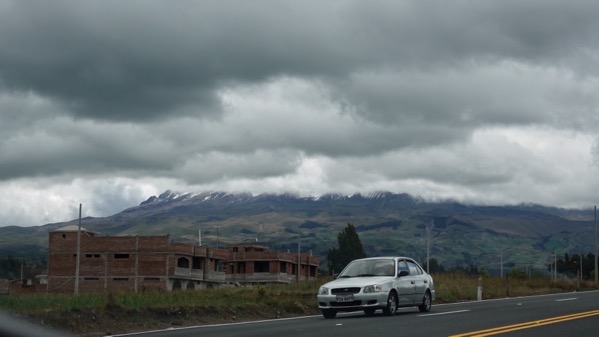
Aha! There’s what we can see of Volcan Chimborazo. Because the earth is not round, and is “squashed,” the top of Chimborazo, at 20,548 ft, is the farthest place on land from the center of the earth. Here we see the lower flanks, and just above where we see snow, the clouds cover the peak and the glaciers there.

Unusual wooden building, with structural elements revealed. Many windows on the second floor, and none on this side on the first.

Pipeline construction on the other side of this quebrada.

We have seen at least two dozen groups of workers trimming the median, and sometimes the sides of the roads. They trim the grass and larger plants, then blow or sweep the bits up, leaving the ditches clean and the surface manicured. I have not see a truck with them yet.

Helado (ice cream) and fruit, cold drinks and snacks. Roadside alimentary temptations. In Mexico snacks is tacos or bocadillos; here it’s more commonly meriendas, which pertains to the afternoon, at least technically.

Elaborate firefighter statue.
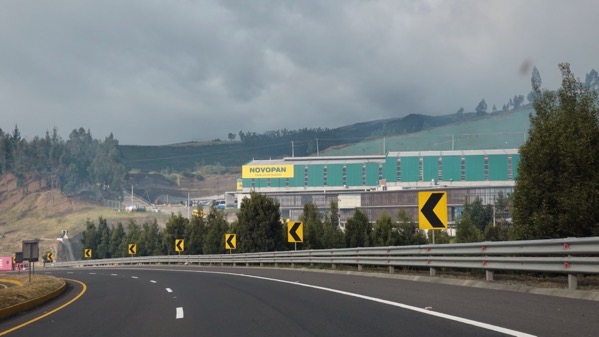
Large wood flooring factory.
Posted at 10:22 PM |
1 Comment »
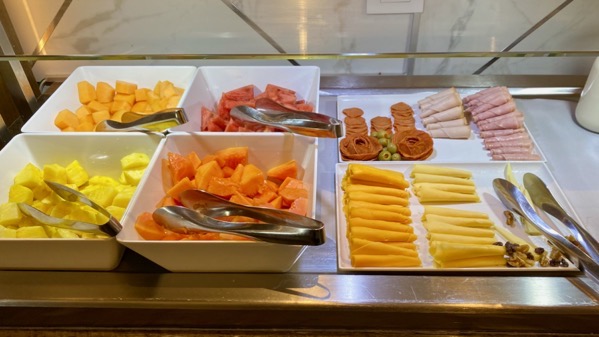
A hot breakfast comes with our room near the Quito airport. Nice, but not the quality that Alejandro and Washington produce on the Grace. Or I’m sure the other chefs that work there when they are off. Interesting sausage-slice “flowers.”

John went and got our rental car, not as straightforward as you’d think, but not too terrible. We set off northward, toward and to Ibarra. Row crops and fallow fields mosaic.

Crossing Río Guachalá.
These photos are not terribly good. Please look beyond reflections, dirty windows, and distracting power lines to absorb what they capture about the Andes and the people living there now.
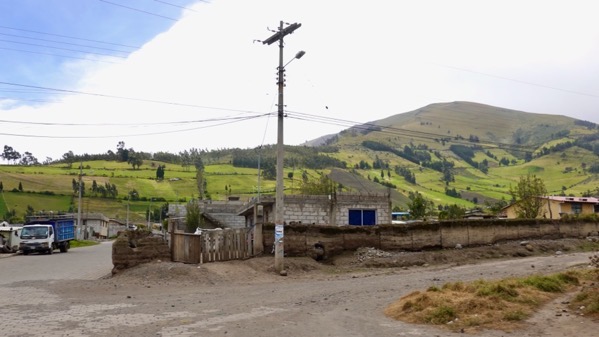
Note the adobe wall separating this lot from the street/ditch. Much of our first leg was away from the normal long-distance traffic, and rural life was more apparent. Commercial activities are focused along the main roads. Along with many busy buses.

While most areas have straight-walled domiciles, this is one of two areas where we noticed these overhanging second stories, sometimes with an ambitious additional overhanging third story.

Green. Lush. On Galápagos, we heard it was the dry season. Doesn’t seem the same here. Of course, the mountains making the clouds rise will bring rain.

Only really old vehicle I’ve spotted. Many dating back to the 1970s, however.

Urbanization. Ibarra.
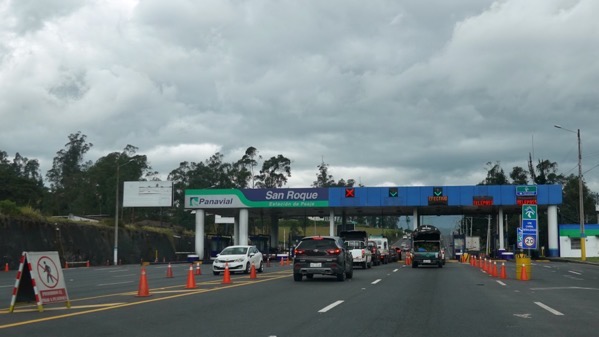
Scattered toll plazas, not particularly frequently. Always one dollar.

Scrappy neighborhood with scrappy roads. Think about what happens after a good rain. And many people navigate these streets on foot, like this tiny elderly woman on the right.
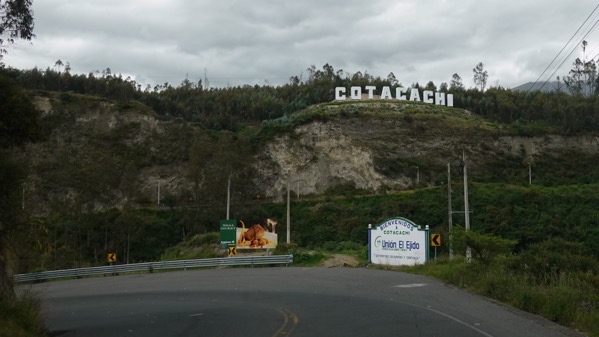
Many towns have large artsy signs, sometimes with a statuary. This is the only one that we saw riffing on the Hollywood sign.

If this were Mexico, I’d call this a zocaló in front of the Palacio Municipal. I don’t know if either of these terms are used in Ecuador.

We took a detour to see Laguna Cuicocha, dramatically within Cuicocha’s caldera. With two islands.

Truly lousy photo of a careful stack of maize stalks, with all the butts to the exterior. I will look for another one, but may not find one during our brief survey. Fascinating. I presume the stalks are for animal feed.

Valley town.

I’m calling this Flower Town; more stands sold flowers than groceries. Some or many of the shade houses around here must hold flowers. Flowers are a pretty way to export water.

Let’s close with this tree, festooned with lichens(?), rather cloud-forest-y.
Posted at 10:22 PM |
Comments Off on North exploration

Pre-dawn. The colors are ripening.

Left for a wee panga tour of Caleta Tortuga Negra, called Black Turtle Cove in our literature, on the north side of Santa Crúz island. We left at 6am, or dawn. First up: cattle egrets, still in overnight positions at 6:07am.
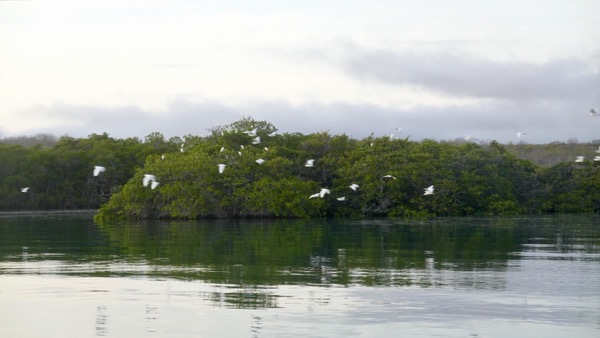
Less than thirty seconds later: the exodus begins. They fly way inland to feed all day.

About two minutes later; heading deeper in the cove. Sky color still eye-catching.

I could see the napping shark here with my eyes, but my otherwise talented camera could not. This cove is a shark nursery. We saw several young reef sharks and more adults in this cove.

Ducking to get deeper in the cove.

Sea turtle? Can’t remember.

We returned to the larger, outer cove in time to see a feeding frenzy. What you can’t see is that a shark (or perhaps two) came at a school of larger fish, which turned tail and scooted the only safe direction: up. And the birds could see this happening, and hunted the school from above. Carnivores.

Great egrets. Sleeping in compared to the cattle egrets. This was twenty-seven minutes after the cattle egret shots.

Heron, pretty sure, but don’t remember which one.

Rounding the Grace’s stern just before 7am, ending our last wildlife adventure.

We breakfasted while the captain moved Grace into position for us to disembark for the last time. Our breakfast assortment included tamale with a fat sliver of yummy cheese. The maize flour has far more flavor than boring MaSeCa.
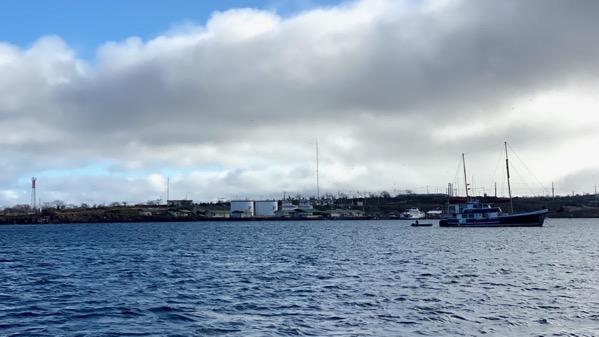
The dock we’re headed to is behind that fancy sailing ship.

It’s our final panga ride, of course wearing our life-jackets, with one of these dangling on either side. Despite temptation, I never pulled one. 😎

Waiting for our plane to arrive; it was a little late. We left through Gate 3. While waiting a pair of finches were flying hither and yon beneath this high ceiling and far below that giant fan. One briefly landed on my hat as I sat quietly pondering our terrific trip. Of all things.

Our final steps on Galápagos were on Baltra Island, headed for our ride. Seats 5A and 5B.

Our bland, large, corporate hotel room near the Quito airport NNE of Quito in the next valley. We are clearly no longer on the Grace.
Posted at 10:22 PM |
Comments Off on Flights
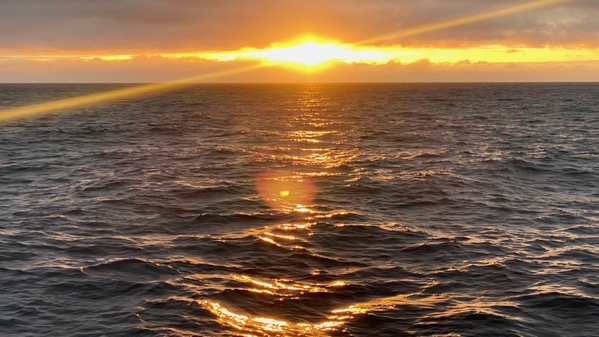
Another glorious sunrise.

Clockwise: husband coffee, wife coffee, husband batman oreos. Actual breakfast followed.

Commonly described as resembling a “Chinese coolie” hat, feast your eyes on Sombrero Chino, the destination of our immediately-after-breakfast walk. [When will this island be renamed for PC reasons?]

It began with a panga tour along a section of the lava-liscious coast, searching for wildlife.

Aha! Close view of a Galápagos hawk. Truly special to see it like this.

Wet landing, then part of the walk was on coral bits. This is the first time we’ve seen concentrations of coral like this.

Lava flow, cooled in place on its gravity-fed descent.

Water meets lava.

We spent some time watching the land iguanas emerging from this space between rocks where they had huddled together for warmth through the night (it was still early). They would stop almost immediately, perhaps doing internal iguana-yawns. Here are two adults and two young.
Back aboard we had lunch followed by our check-out briefing. Sad to contemplate the end of our fabulous excursion in the eastern Galápagos, the part with the older islands—older geologically, so more soil development in general, enabling more diverse plant life.
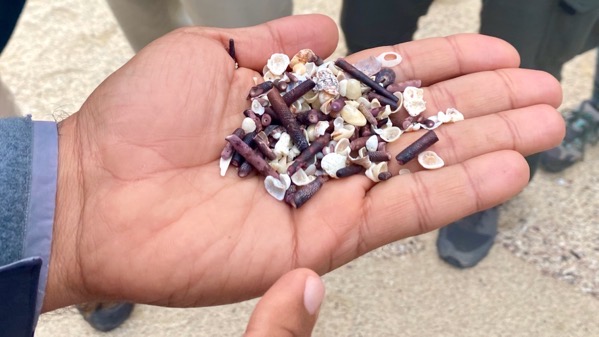
Afternoon dry landing on Cerro Dragón. This beach had teeny shells and sea urchin spines. Those are the fat tubes in Gustavo-the-Guide’s hand. He said his father and his contemporaries used those spine chunks on slate in school, and thus the common name is pencil sea urchin.

The tide was out a bit, exposing a sandy area with many hermit crabs, mostly not seen. They did leave evidence, not only their burrows, but also these sand balls. They take in the sand, filter all the organic matter that’s in it, then spit out the sand in these little balls.

Sleeping/resting dragon.

Brackish pond.

Stilt? Already forgot.

It took Gustavo’s sharp and well-trained eyes to spot this katydid, right by the trail.

Mature male land iguana. “Doing what they do best,” as Gustavo said.

Mature male iguana in “our” trail. Burrow nearby. Linear patterns in the sand are tail drag marks.

Finch.

View to sea.

Bartender Javier’s preparations are underway for the goodbye meet-up and toasts with the crew. Scarlett the Cruise Director once again went along the crew line-up, detailing their responsibilities and names. [This also helped us with tipping before we disembarked.] Several of us short-timers made a little speech of thanks. I did one in Spanish on behalf of all of us; my Spanish, although still stilted, has come back relatively rapidly after, what?, perhaps twenty-five years of disuse. Good for my brain.

Best tomato soup I’ve ever had. I am not a Campbell’s fan. This has no cream, and includes potatoes. The crew kindly used Google translate to make and print a recipe for several interested guests. The first ingredient was a certain amount of “dad.” Someone among us was clever enough to realize this was a translation of “papa.” While, of course, not an incorrect translation, it was the wrong one here. Papa means papa/dad, the Pope (as in Father), as well as potatoes.
Posted at 10:22 PM |
Comments Off on Renaming ahead?

We traveled overnight, and boarded pangas starting at 6am to walk on North Seymour Island. The park regulations say that no one can be on land between 8pm and 8am. They require overnight ship passengers are only on land until 10am and after 3pm. The day-trippers get the hot, bright hours in between when many of the animals are far less active. I checked and this photo was at 6:07am, just after we started walking. Pretty sure these are frigate birds.
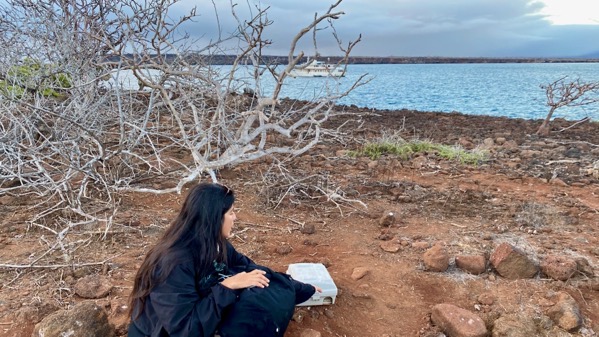
Sofia is discussing rat problems. The trap has low-level sulfur in it, enough to kill the rat after a time, and not enough that a hawk will sicken from eating it. Rats are of course introduced, and a problem along with goats, dogs, cats, and at least one insect, all causing significant problems.

Call this a frigate bird condo. Frigate birds don’t need much personal space, as you can tell, so the gents try to build their nests in the best trees, to catch a lady frigate bird. The red sacs take perhaps twenty minutes to inflate or deflate. They attract lady frigates to check out nest quality. If the latter meets spec, they will stay and mate.

Frigates pairing up.

Beautiful morning rainbow omen.

If I have it right, the Galápagos islands were stripped of this lichen at one time, to sell for making a purple dye. Lichens are of course slow-growing, so it has taken many decades for them to return.

Land iguana.

Posing bird. I’m anthropomorphizing.

See the two islands? Those are the Daphnes, with Daphne Major to the left, and Daphne Minor to the right. The famous forty-year study of finches by the Grants was on Daphne Major. Others have continued studies. Check out “The Beak of the Finch: A Story of Evolution in Our Time” by Jonathan Weiner if you’re interested.
On land you can see pairs of white stakes. We only walk between them.

When the booby parent comes back from fishing, the booby baby (technical naturalist term), bangs beaks with the parent. This eventually stimulates the parental bird to regurgitate. The chick sticks its head down the parental throat to get the food.
Aren’t you glad this isn’t the human style.
Back aboard, the Grace got underway and we had breakfast, then most of us watched two very well-made videos, one on Darwin and Wallace, and one on von Humboldt. The latter was a contemporary of Thomas Jefferson, and probably the first person you could consider a modern naturalist, at least in the Western world. I’m going to hunt up a copy of Wulf’s “The Invention of Nature: Alexander von Humboldt’s New World” to read up on this fascinating man and how he laid the groundwork for his successors.
Next, we had a lovely snorkel followed by a late lunch, if I have it right. Or perhaps the snorkel was after lunch? I forgot to record some details.

Our late-day panga trip located, tada!, penguins. The only tropical penguins. Soooo wonderful.
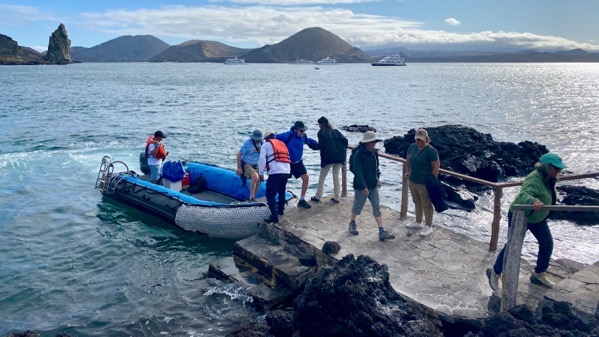
This is a dry landing on Bartolomé. Many other ships in this area.

Bartolomé has a boardwalk, only it’s mostly steps. It goes to the top. We made many photos in the late-day sun.

Note the many cinder cones. Sooooo different from every other island we’ve visited.
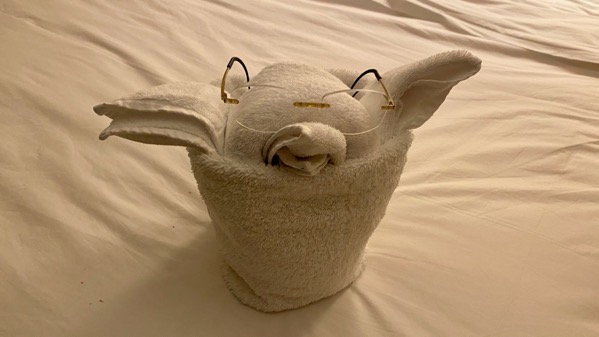
When we return after our afternoon excursions, we are greeted by a critter. I think this is a towel owl, a short-eared owl, yet, oddly wearing (my) spectacles. Teehee. John says its a baby Yoda.
Posted at 10:22 PM |
Comments Off on North and west
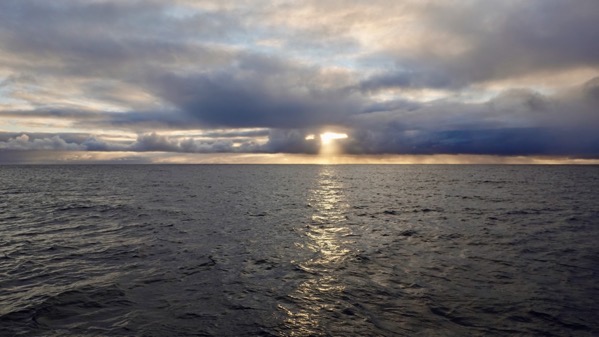
There’s no such thing as too many beautiful sunrises.
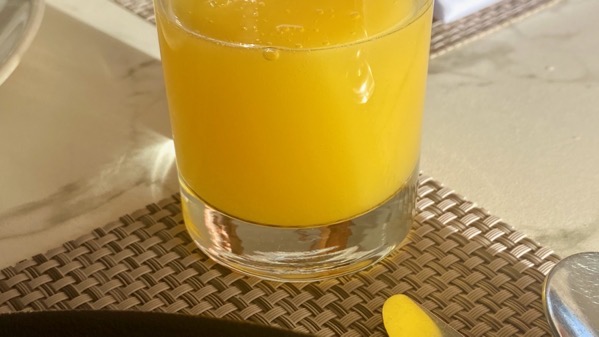
Juice every morning, and every morning a different fruit. This may be what everyone called tree tomato. I just checked the internet, and in New Zealand it’s called tamarillo. It’s in the Solanaceae family, and is Solanum betaceum. Now I know.
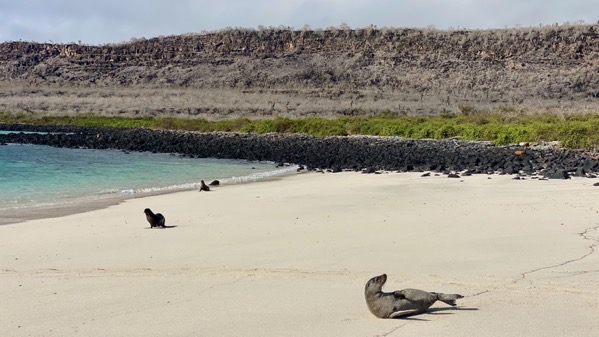
Right after breakfast, we had a wet landing on Santa Fe Island. The sea lions were just becoming active.

This was a short walk to see these giant-size opuntias. The pads are not tasty to humans, but are the favorite of land iguanas.
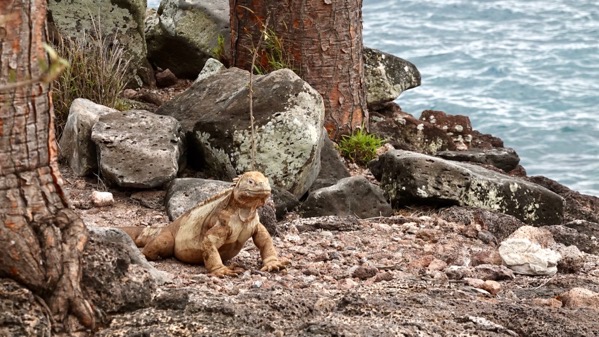
Right on schedule, here’s a large male land iguana.

And another.

Back on the Grace, the crew lowered kayaks and the pangas took us to a good kayaking spot.
After that, we changed into wet suits for a snorkeling expedition. Again, no photos of these two activities. Salt water, you know.
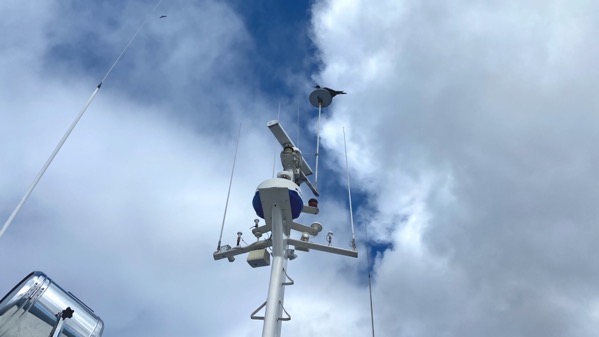
After lunch, I spotted this hitchhiker. Another came and ousted it.
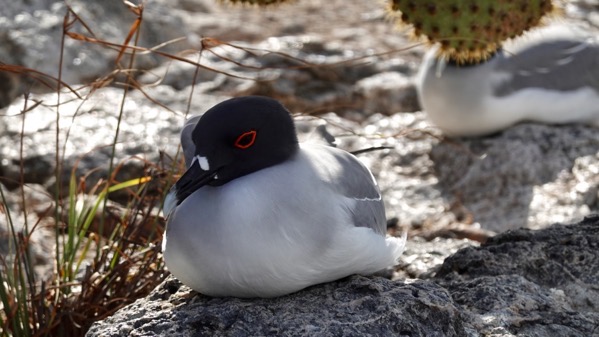
Dry landing on South Plaza island, and a slow 90-minute loop. Nocturnal gull.
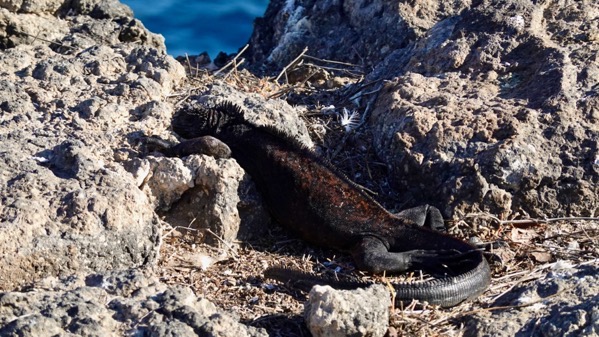
Marine iguana. Note longer narrow tail, used as a paddle in the water. Also, the land iguana’s tails are more rounded on the bottom, a good tip if you find their tracks.

A finch busy looking for…seeds, I think.

Little lava lizard…little compared to the iguanas. On the “trunk” of one of the tall opuntias.
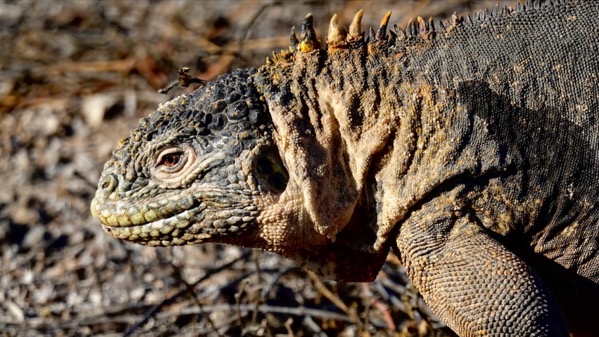
Land iguana profile. Those neck spikes draw my eye every time.
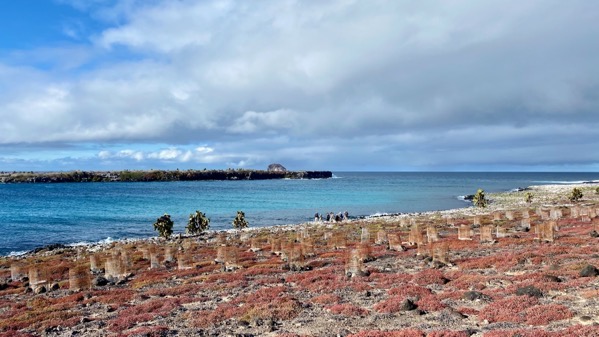
The iguanas have so aggressively dined on the opuntias on the west end of South Plaza that the park folk have planted new ones, with these protective cages. Still, they have had to replant and replant, as the small opuntias are easier for the iguanas to climb and access the pads, as you might guess. Even with the protective cages.
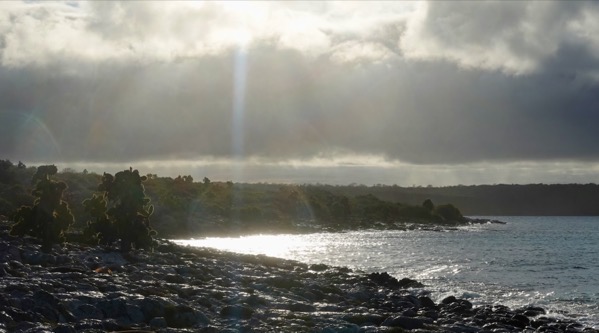
Sun is cruising down, although it’s still an hour and a half to sunset.

Sous Chef Washington’s tiramisu was a resounding success. Several of us thought it the best we’d ever had.
Did you catch that we did a walk, a kayak ride, and a snorkeling expedition all before lunch? I have never changed my clothing so many times day after day in my life.
Posted at 10:22 PM |
Comments Off on Enough iguanas?

Too overcast for a dawn photo, so here’s the coffee, tea, and water station. That’s an urn of fine organic Ecuadoran coffee on the right, with a Euro coffee machine that makes latte machiatos, cappuccinos, and the like. Cold and hot water to the far right.

First off-ship activity: land on that beach to the left, walk into the interior, turn to the left and walk to cliffs on the other side, return.
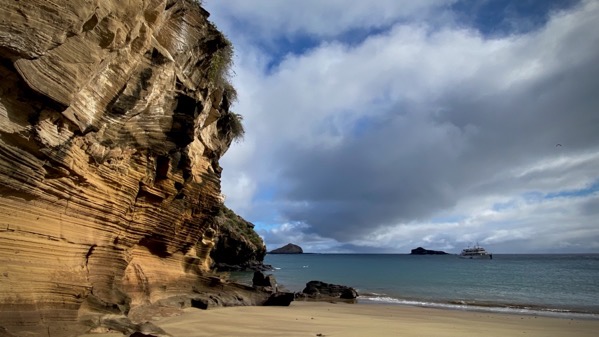
This is the rock on the “right” end of the beach. Looks like funky sandstone, right? It’s compressed volcanic ash deposits from many different eruptions, if I have it right.
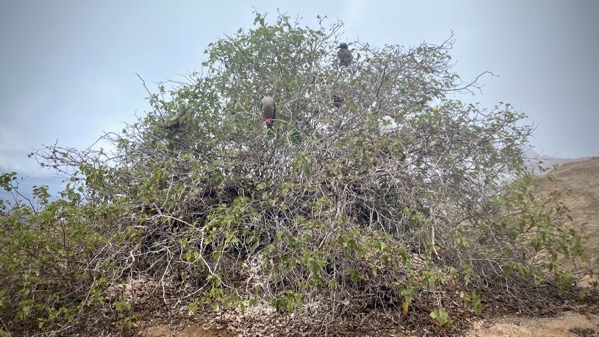
Red-footed booby condo. At least five families/nests here. Males build a nest then advertize it to the lady-birds. Location and nest quality are everything to the ladies, in that order. This is a safe tree in an excellent location.
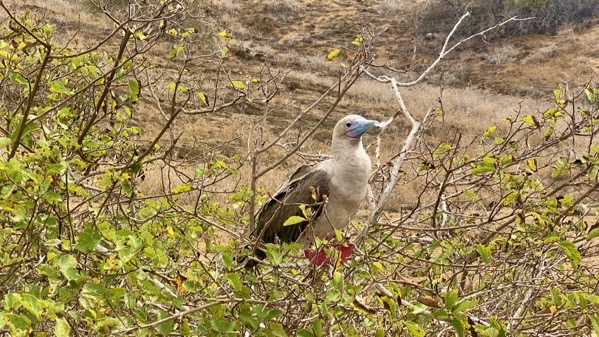
Very red, those feet. Beak is a light blue.

Endemic locust.

Eastern-most point on Galápagos archipelago: Punta Pitt.
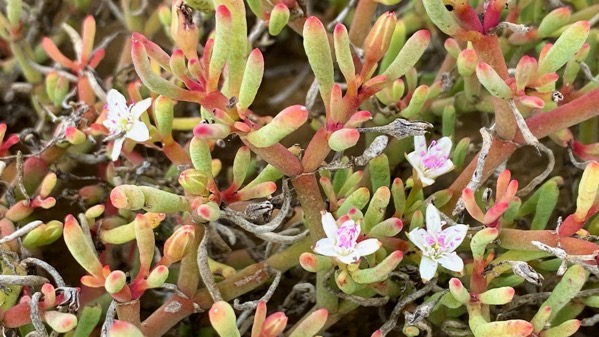
Blooming succulent, possibly common carpet weed.
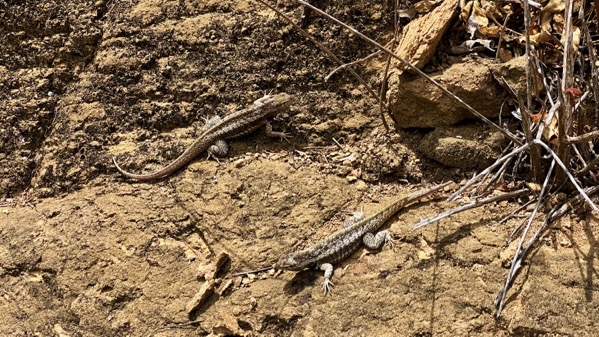
Fighting male lava lizards. This is not territorial, it’s just to fight. They run in a circle, then use their tails to thwack the other guy. The male on the left has an advantage in this, as he has all his tail, and the opponent has a shortened tail.
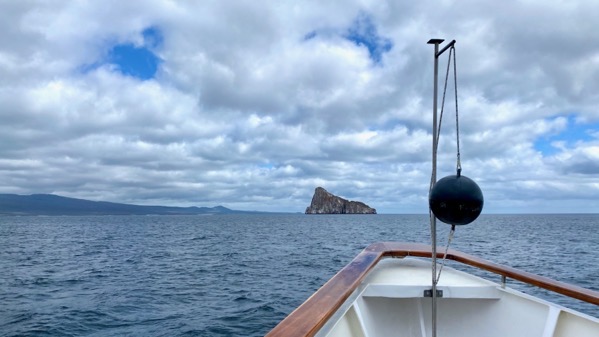
This is Kicker Rock. It’s darned famous. Our captain circled it. Since it was mid-afternoon there were only a few birds, but several hours later, many would return from fishing expeditions, we were told.

Kicker Rock is actually two rocks. Those slabs of white on the sides: guano. Not mineralization or geologic formation. Next, we did a snorkeling expedition from the pangas. Lots of fish species and many sea lions. Very large sea urchin sand dollars. Fabulous snorkeling.

Pelican. Isla Lobos.

Candelabra cactus, with ever-present guano-ed rocks.
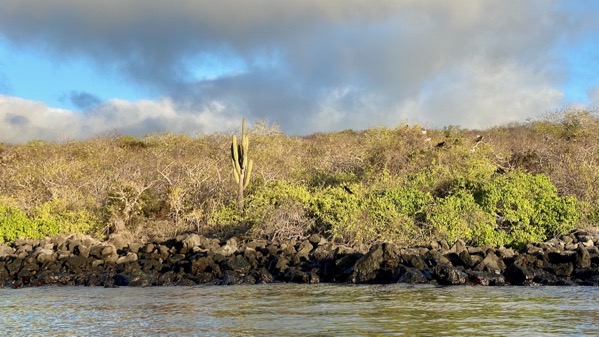
San Cristóbal vegetation.
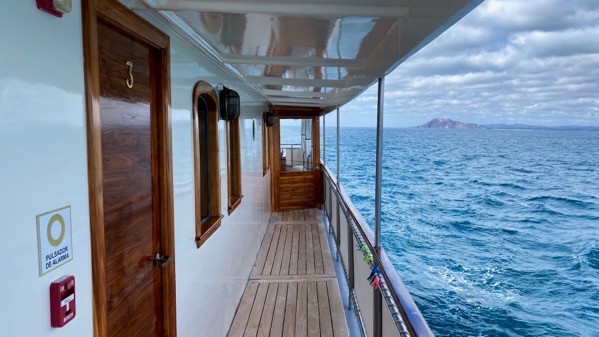
Our cabin door and two windows, view toward stern.

Almost sunset. Remember this is the equator. Year-round, sunrise and sunset are at 6 am and 6 pm, or pretty darned close. No change. And the light changes fast.
Posted at 10:22 PM |
1 Comment »

We began our days adventures on and around Española by landing on a small cement jetty and walking past dozens of marine iguanas just waking up…

…as well as these bright sally lightfoot crabs who were already very active.

Our first obstacle was a crowd of marine iguanas and a mother sea lion and her wee pup (black triangle behind mom). The iguanas weren’t warm yet, and so still congregated as they had been through the night to share warmth. In truth, they are not social creatures.

Our walk took us to a cliff-side overlook with wheeling birds of several species, and crashing waves.

Blue-footed boobies on the ground and a tropicbird showing off its long tail in the air.

Our guide, Sofia, stopped us frequently to point out something or to discuss evolution, vegetation, geology, inter-island variation, and the like.

I particularly enjoyed the plumes of water of the breaking waves.

Blue-footed booby parent with two chicks.

Here, a pair of Galapagos albatrosses (Phoebastria irrorata) are desultorily attempting courting. They split up soon after.

Some places the vegetation was very dense. This is not dead, merely leafless in the dry season.

The marine iguanas festooned the rocks and sand above the water line…only a few were warm enough to be down in the water or by it feeding. The red patches remain on the females, but are fading as the mating season has ended.

Returning to the jetty, we watched this sea lion mom, the one we saw by the path earlier, moving the pup up from the water line, as the tide was coming in. It was squeaking some from being grabbed and dropped, although the mom was careful enough.

For lunch we were honored to have ceviche of pez brujo, or scorpionfish. It was the appetizer of an Ecuadorian meal that was spectacularly yummy. We had timbalitos for breakfast, a sweetened maize dough wrapped in banana leaves and steamed as you would tamales. The main protein dish was a choice of a roasted pork or a cazuela (bowl) of mixed seafood in a mashed green plantain soup to make a stew.

Here’s the ceviche. Phenomenal depth of flavor in the broth. Oh, and dessert was a scoop of blackberry ice cream, and a scoop of subtle mint ice cream, with a little hard sweet biscuit. Yummy, that Ecuadoran food!

After lunch, we had a bit of unstructured time, then met at three ready to load the pangas for another snorkeling expedition along a rocky cliff, so we could look down and at the wall, or cliff face below water. I saw many kinds of fish, one turtle on the bottom, and several sea lions came and played with us and around us: incredible. No photos. The we rebounded and changed into dry clothing to stroll this beach on our own. It’s supposed to be one of the most beautiful in the Galápagos. It certainly was beautiful.
That’s the Grace offshore. This sea lion was playing in the water when we spotted it, then we followed it as it carefully moved along the beach, on and on until I lost sight of it. I think it had been sleeping and its group had moved on, leaving him/her alone. It stayed among the breaking waves, scooting along in the surf over the sand and sometimes going far enough out to swim a short distance, then returning to the surf-breaking area. My theory is that out farther was too dangerous, a lone sea lion would be quite the mean for a roaming shark. I silently wished her/him luck in finding safety.

One more food shot. The extremely talented chef, Alejandro, and I have had several chats about my low-glycemic index diet, and he has been kind enough to make small alterations in the servings/dishes for me. He’s a young guy and oh so creative. This is a salmon taco appetizer, which he put on a lettuce leaf for me, rather than a traditional tortilla. He also put the red bean paste on the side as an option. It had the creamiest guacamole I’ve ever had.
Posted at 10:22 PM |
Comments Off on Española

Up with the dawn.

And saw the sunrise. We traveled overnight to Floreana Island, and anchored offshore.

That’s our yacht, Grace, in the background. We were ferried to shore in pangas, and with the many activities today, we’ll become very familiar with various ways and situations relevant to entering and exiting a panga, Galápagos style.

Our first excursion was before breakfast, a quick trip to the local post office, old style. Sailors used to stop here and leave mail for a later ship going in the appropriate direction, and collect mail for whomever they could deliver to. We left a few postcards in the spirit of this continuing instituion, and some folks took one to deliver. The delivery is meant to be done in person. This is especially ironic as the postal service for Ecuador has been closed as a cost-cutting measure, leaving DHL and FedEx as options.

Returning to the Grace. Next we were instructed about kayaking and snorkeling. I have no photos of these activities. Too close to salt water. I have now been on my first kayak ride. The Grace carries eight two-seater kayaks, enough for all clients to go at once. Most of us did. Saw green tortoises in the water and sea lions and blue footed boobies on land. Among others.
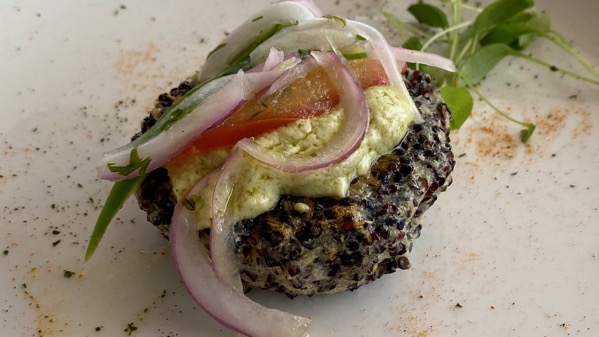
A quinoa croquette, our lunch starter. Lunch was followed by re-donning our wet suits, hoods, and neon life vests for a deep-water snorkeling experience among some volcanic formations that spear the sky (very vertical and craggy).
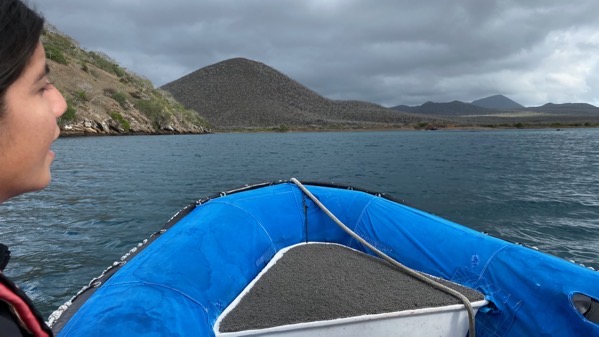
Our late afternoon activity was a nature walk on Floreana. Here, we’re headed for our landing place.
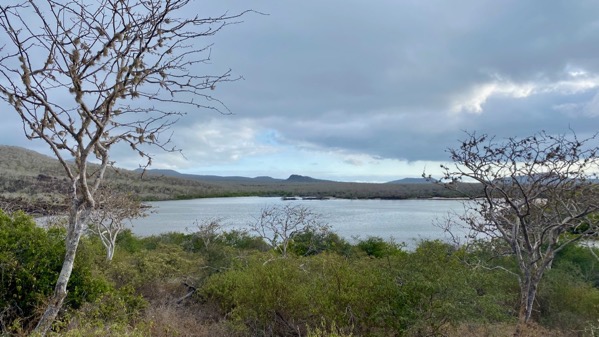
We started into the interior of the island and skirted this brackish pond. I saw several pink flamingoes with binoculars on the far side. Genetically, the flamingoes here are most similar to ones in the Caribbean.

We kept walking and popped out on a beach on the opposite side of the island, just in time to witness a bit of a feeding frenzy. Several sharks, diving frigate birds, and rays.

We enjoyed our meet and greet of the staff tonight. Yesterday was too complicated to insert that important activity, although you would expect it on Day One. The crew showed up in their dress uniforms, all white and starched. We attempted our most formal wear. The social director, one very lovely and super-helpful Scarlett (yes, named after Atlanta’s Scarlett) introduced each of the crew members and detailed their responsibilities, and then we introduced ourselves to them.
Previously, I didn’t know who the captain was, and was looking forward to seeing him. I was surprised to discover I had spoken to him several times during panga entrance and exit activities, and he had sprayed my feet with clean water after a snorkeling expedition. Rather egalitarian, ¿no?
Posted at 10:22 PM |
Comments Off on Busy on sea and land
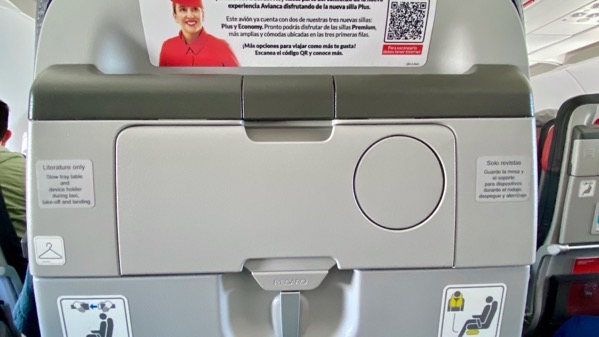
Took the hotel shuttle to the airport, and went through special bureaucratic hoops to initiate our entrance into the Galápagos province. Our flight was on an Airbus, with new seats. And new vocabulary: código QR and rodaje. The latter means when taxi-ing.

Here’s our plane disgorging tourists (and a few locals). We found more bureaucratic hoops in the terminal, nothing that wasn’t solved by standing in line and presenting documents.

However, the airport is on Baltra, and we wanted to be on Santa Cruz, and there were many sturdy ferries to move us…

…and our luggage across the Itabasca channel. Yes, that’s the boat we rode in, and that’s our luggage on the roof. Darned sturdy roof.

Our first stop was a turtle sanctuary, where we ate lunch. Having gotten out of bed at 4:40, and it being after one (plus one time zone change), during which time we had little food and no coffee…we were darned glad to tuck into a superb spread cooked by the chef and team from our yacht, Grace. After dining, we donned lovely rubber boots, and took a stroll.

Here’s one of our two guides helping us understand the intricacies of tortoise life, love, and subsistence.

Most of the tortoises we saw were large males, which are typically about three times the size of the females.

We even got to see a lava tube. These are volcanic islands, like the Hawaiian archipelago, but much, much smaller.

Refreshed and excited from many turtle sightings, we bussed through Puerto Ayora to the harbor.
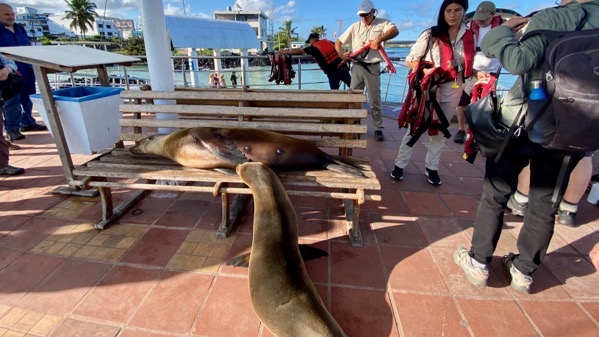
Right by where we put on our life jackets, a pregnant mama sea lion was zoned out while her very large offspring was dining on all milk s/he could extract.

Fascinating feet. Flippers.

We rode on pangas (dinghies) out to the Grace. Wonderful to have arrived at our home-for-a-week. Gorgeous sunset over Puerto Ayora.

And a giant moon in the opposite direction. This is the largest yacht allowed to ferry tourists in Galápagos waters. It has 100 guests. The Grace hosts sixteen.
Reminder: when the post time is 10:22 pm, it was posted at some point after the day it is dated.
Posted at 10:22 PM |
Comments Off on Making tracks




































































































































































